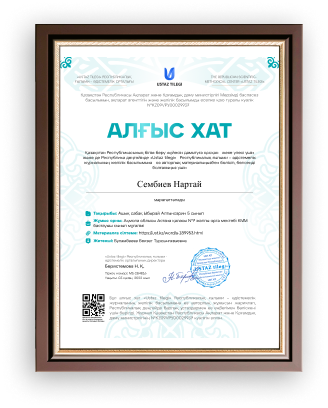
|
Unit 5 Creativity |
Lesson 51 |
|
|
School |
|
|
|
Teacher name: |
|
|
|
Date: |
|
|
|
Grade: 5 |
Number present: |
absent: |
|
Lesson title |
Types of films |
|
|
Learning objectives
|
5. 2. 5. 1 understand with support most of the specific information and sections in short conversations on different learning topics; 5. 3. 4. 1 respond in sentences with some flexibility to unexpected comments on a variety of general and academic topics; |
|
|
Lesson objectives |
Learners will be able to: - consolidate information from a text - To practise agreeing/disagreeing about your taste in films - To present adjectives and practise using them to describe films |
|
|
Value links |
"Law and Order" Ensuring the protection and safety of society understand the importance of law and order as |
|
|
Plan |
||
|
Stages / Time |
Teachers actions |
Students actions |
Assessment criteria |
Resources |
|
Beginning of the lesson 5 min
.
Middle of the lesson Presentation part. 35 min |
Organization moment : 1.Greeting. Ask about the weather. Warming up The teacher sets the lesson objectives, letting students know what to anticipate from the lesson. Lead – In
Ex:5 P:59 Allow Ss time to write their sentences. In closed pairs, Ss then read their sentences to their partner who correct the mistakes. Monitor the activity around the class and then ask some pairs to report back to the class.
|
Students of the class are listed. Students' attention is drawn to the lesson. Determines the topic and purpose of the lesson
Students say different words from the picture Answer the question.
Pupils look at the pictures, choose a creature and write a few sentences about it. Make two mistakes. Read it to your partner, who corrects you. ANSWERS Centaurs were half human half bird. (half human half horse) Centaurs lived by the sea. (in the mountains and forests) The Phoenix was a golden bird with a red tail. (red bird with a golden tail) The Phoenix was from Greece. (India and Egypt) The Chimera had three heads from three different animals: a lion, a dog and a snake. (lion, goat, snake) It could breathe ice. (fire)
|
The teacher to assess learners for their ability. “Good job! Well done!” Formative Assessment
Good job!
Descriptor: - look at the pictures - choose a creature and write a few sentences Total: 2 point
|
|
|
|
Ex: 6 P: 59 Go through the list of film types and explain/elicit the meanings of any which are unknown. Ss complete the task. Check Ss' answers. Point out that some types of films do not take the word 'film' after them (e.g. western, horror, musical etc).
Ex: 7 P: 59 Elicit/Explain that we can use So + auxiliary verb + personal pronoun/noun to agree with what a person has said or Neither + auxiliary verb + personal pronoun/ noun to agree with sth negative that sb has said. Ss talk in pairs about their taste in films. Monitor the activity around the class and then ask some pairs to ask and answer in front of the class.
Ex: 8 P: 59 Explain the task and read out the example exchange with a S. Ss then complete the task in pairs. Monitor the activity around the class and then ask some pairs to ask and answer in front of the class. Differentiation: «Verbal support» method is used to help Ss use new words in the sentences. |
Pupils match the titles to the types of films. Make sentences. ANSWERS 2 j 3 b 4 i 5 e 6 c 7 k 8 h 9 a/g 10 d 11 g/a 12 f
Pupils work in pairs talk about types of films, as in the examples ANSWERS A: Do you like animated cartoon films? B: Yes, I love them. A: So do I. They're funny. B: How about historical films? A: I don't like them. B: Neither do I. They're boring. A: I don't like detective films. B: Really? I do. A: I like science-ficti
Pupils use the words to talk about the films in Ex. 6 ANSWERS A: 'Cowboys' was on TV last night. B: Really? What was it like? A: It was very interesting.
A: 'Mickey Mouse' was on TV last night. B: Really? What was it like? A: It was very funny. A: 'Detective Mallory' was on TV last night. B: Really? What was it like? A: It was very interesting.
A: 'Dracula' was on TV last night. B: Really? What was it like? A: It was very frightening.
A: 'Funny Faces' was on TV last night. B: Really? What was it like? A: It was very funny. |
Descriptor: - match the titles - make sentences. Total: 2 point
Descriptor: - work in pairs - talk about types of films Total: 2 point
Descriptor: - complete the task in pairs - use the words to talk about the films Total: 2 point
-Make CCQ questions Yes / No Total: 1 point
|
|
|
End of the lesson 5 min |
FEEDBACK Learners provide feedback on what they have learned at the lesson. Ex: P: Home task: Write the days |
Ss evaluate each other and encourage classmate with phrases like: Well done! Brilliant! Good job! I like it!
|
|
|
жүктеу мүмкіндігіне ие боласыз
Бұл материал сайт қолданушысы жариялаған. Материалдың ішінде жазылған барлық ақпаратқа жауапкершілікті жариялаған қолданушы жауап береді. Ұстаз тілегі тек ақпаратты таратуға қолдау көрсетеді. Егер материал сіздің авторлық құқығыңызды бұзған болса немесе басқа да себептермен сайттан өшіру керек деп ойласаңыз осында жазыңыз
Types of films grade
Types of films grade
|
Unit 5 Creativity |
Lesson 51 |
|
|
School |
|
|
|
Teacher name: |
|
|
|
Date: |
|
|
|
Grade: 5 |
Number present: |
absent: |
|
Lesson title |
Types of films |
|
|
Learning objectives
|
5. 2. 5. 1 understand with support most of the specific information and sections in short conversations on different learning topics; 5. 3. 4. 1 respond in sentences with some flexibility to unexpected comments on a variety of general and academic topics; |
|
|
Lesson objectives |
Learners will be able to: - consolidate information from a text - To practise agreeing/disagreeing about your taste in films - To present adjectives and practise using them to describe films |
|
|
Value links |
"Law and Order" Ensuring the protection and safety of society understand the importance of law and order as |
|
|
Plan |
||
|
Stages / Time |
Teachers actions |
Students actions |
Assessment criteria |
Resources |
|
Beginning of the lesson 5 min
.
Middle of the lesson Presentation part. 35 min |
Organization moment : 1.Greeting. Ask about the weather. Warming up The teacher sets the lesson objectives, letting students know what to anticipate from the lesson. Lead – In
Ex:5 P:59 Allow Ss time to write their sentences. In closed pairs, Ss then read their sentences to their partner who correct the mistakes. Monitor the activity around the class and then ask some pairs to report back to the class.
|
Students of the class are listed. Students' attention is drawn to the lesson. Determines the topic and purpose of the lesson
Students say different words from the picture Answer the question.
Pupils look at the pictures, choose a creature and write a few sentences about it. Make two mistakes. Read it to your partner, who corrects you. ANSWERS Centaurs were half human half bird. (half human half horse) Centaurs lived by the sea. (in the mountains and forests) The Phoenix was a golden bird with a red tail. (red bird with a golden tail) The Phoenix was from Greece. (India and Egypt) The Chimera had three heads from three different animals: a lion, a dog and a snake. (lion, goat, snake) It could breathe ice. (fire)
|
The teacher to assess learners for their ability. “Good job! Well done!” Formative Assessment
Good job!
Descriptor: - look at the pictures - choose a creature and write a few sentences Total: 2 point
|
|
|
|
Ex: 6 P: 59 Go through the list of film types and explain/elicit the meanings of any which are unknown. Ss complete the task. Check Ss' answers. Point out that some types of films do not take the word 'film' after them (e.g. western, horror, musical etc).
Ex: 7 P: 59 Elicit/Explain that we can use So + auxiliary verb + personal pronoun/noun to agree with what a person has said or Neither + auxiliary verb + personal pronoun/ noun to agree with sth negative that sb has said. Ss talk in pairs about their taste in films. Monitor the activity around the class and then ask some pairs to ask and answer in front of the class.
Ex: 8 P: 59 Explain the task and read out the example exchange with a S. Ss then complete the task in pairs. Monitor the activity around the class and then ask some pairs to ask and answer in front of the class. Differentiation: «Verbal support» method is used to help Ss use new words in the sentences. |
Pupils match the titles to the types of films. Make sentences. ANSWERS 2 j 3 b 4 i 5 e 6 c 7 k 8 h 9 a/g 10 d 11 g/a 12 f
Pupils work in pairs talk about types of films, as in the examples ANSWERS A: Do you like animated cartoon films? B: Yes, I love them. A: So do I. They're funny. B: How about historical films? A: I don't like them. B: Neither do I. They're boring. A: I don't like detective films. B: Really? I do. A: I like science-ficti
Pupils use the words to talk about the films in Ex. 6 ANSWERS A: 'Cowboys' was on TV last night. B: Really? What was it like? A: It was very interesting.
A: 'Mickey Mouse' was on TV last night. B: Really? What was it like? A: It was very funny. A: 'Detective Mallory' was on TV last night. B: Really? What was it like? A: It was very interesting.
A: 'Dracula' was on TV last night. B: Really? What was it like? A: It was very frightening.
A: 'Funny Faces' was on TV last night. B: Really? What was it like? A: It was very funny. |
Descriptor: - match the titles - make sentences. Total: 2 point
Descriptor: - work in pairs - talk about types of films Total: 2 point
Descriptor: - complete the task in pairs - use the words to talk about the films Total: 2 point
-Make CCQ questions Yes / No Total: 1 point
|
|
|
End of the lesson 5 min |
FEEDBACK Learners provide feedback on what they have learned at the lesson. Ex: P: Home task: Write the days |
Ss evaluate each other and encourage classmate with phrases like: Well done! Brilliant! Good job! I like it!
|
|
|

шағым қалдыра аласыз















